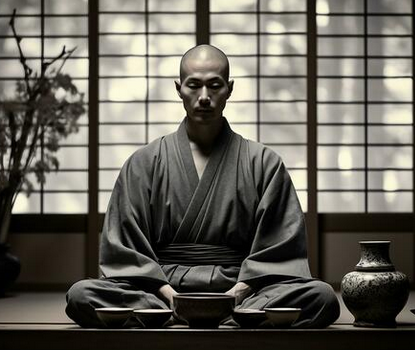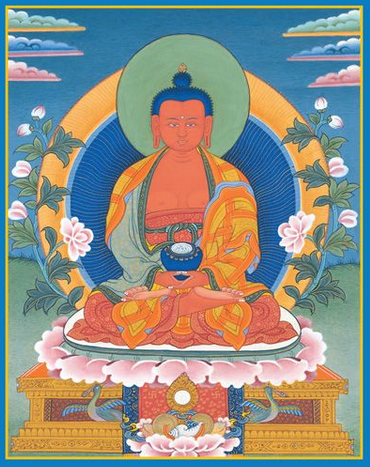**BASSUI** Zen master : who is looking at ?
There are few notable events in Bassui’s life. He was born in 1327 in the current Kanagawa Prefecture. Orphaned of his father at the age of four, he began questioning the existence of the soul at a very young age. At 29, he took his first tonsure. The way he practiced since then is well documented in the letters that make up the Sermon that follows. During his practice, he had several moments of "attainment," but he was never satisfied. He advanced with the mottoes: "Abandon the awakened Awakening and return to the awakening Subject!" and "Break the mirrors!" At the end of his life, he founded a monastery in Enzan, at the foot of Mount Fuji, where he died in 1387. The time during which Bassui lived was about half a century later than the life of Musō Kokushi, but perhaps because he lived far from Kyoto, the center of Japanese civilization at the time, he left no trace in the history of the culture of the Muromachi era. However, the ten letters he sent to his disciples form a purely religious text, rare in the world for the depth of its religious thought. At that time, a literary genre known as the "literature of the Five Monasteries" was popular. Zen monks practiced poetry and prose. Completely outside of this literary genre, Bassui's text, a blunt religious book, focuses solely on the essentials of religion. I myself, during my early practice, always kept this text at hand, as it encouraged, stimulated, and prompted me to reflect. That is why we have chosen it. The originality of this text lies in the opposite direction Bassui gives to the path that is usually followed to unify the "self" and God or Buddha, with these being posed as the object. In other words, his tendency is the opposite of mystical union or the identification of human will with divine will, which is discussed in Western mysticism.
Some think that Zen and Western mysticism are identical, but this text clearly shows the differences between them. Bassui will focus all his mind on a single question: "Who is the one who sees and hears?" That is, "What is our own mind?" Thus, his method of accessing religion is very philosophical. He does not rely on a revelation from Heaven, nor on oracles, nor on any mythology. As a result, his religion is relatively detached from any racial or traditional tint. It is in this sense that it is also relatively universal. This text often emphasizes the process of the search conducted to encounter our "own mind." Suppose our own mind is non-being. This cannot be, since it actually sees and hears. If we take it for being, nonetheless, we cannot find it in a form. As a result, we cannot take it for either non-being or being. People lose all their bearings in the face of this antinomy. They fall into vagueness. But if we continue to concentrate, sitting cross-legged, on the question "Who is the one who sees and hears?" this feeling of vagueness disappears. We reach a state where no cloud tarnishes the serene sky, where our mind is like emptiness, where the mirror is fully polished, where our heart is fresh, and where there is no distinction between inside and outside. People tend to take this for Enlightenment, but this is still not the authentic Enlightenment.
Tetsugen also, in his Sermon, explains with citations from various classical Buddhist texts that this resembles Enlightenment, but is not Enlightenment; that those who practice Zazen must avoid stagnating at this stage; and why this is called "illness." It is like the shadow compared to light, dawn compared to day, but many practitioners stop at this stage. This is because, having reached this phase, those who practice can resolve several religious problems and koans. The "Self" and the object intimately unify, and they can understand the words: "We see all objects as if we are seeing our own face." Or: "The sky, the earth, and 'I' share the same root. Thousands of objects and 'I' form only one body." Or the course of time stops, and the infinite past and future become the present, and we can understand the words: "Eternal present," or: "Now, we see the Buddha Sakyamuni and the patriarchs before us." But sincere seekers will feel that something is still missing, as if they see objects through fog, or as if they are scratching an itch through their shoes. That is why Bassui often repeats: "Abandon the awakened Awakening and return to the awakening Subject!" or: "Break the mirrors!" In short, when we have reached this stage, our mind has not yet reached true Emptiness but is still lingering in a false emptiness. While we stagnate at this stage, we do not understand for ourselves where the mistake lies. We will only understand it for the first time when we have passed the next level by breaking through the present stage. For this breakthrough, Bassui recommends asking even more deeply: "Who is the one who sees and hears?" "... Then, he says, the stage similar to emptiness, where you see nothing, dissipates. You have no taste, and you are in the dark night." This expression of "dark night" is very interesting, as some great Christian mystics have often mentioned this "dark night," such as Pseudo-Dionysius, Saint John of the Cross, Hegel, etc. Bergson himself said about it: "... perhaps, what is most significant, at least most instructive, in Christian mysticism..." But this is not a trait unique to Christianity.
On their part, Zen texts clearly mention it, as we have seen. Although Zen and Western mysticism follow different paths, it is entirely natural that they go through similar phases during inner deepening. Bassui only speaks symbolically in this text when it comes to Liberation or free actions after having reached the Ground. But what attitude does he recommend facing death? For it is in this attitude, facing death, that Liberation is best expressed. Bassui often speaks of vigilance at the moment of death. In Buddhism in general, especially in the Pure Land school, which emphasizes salvation through another being called the Buddha Amitabha, it is believed that the attitude at the moment of death is the determining factor for rebirth in another life. A passage from the "Essential Compendium for Rebirth" (Ojōyōshū) by Genshin, published in 985, clearly outlines this:  "One thought at the moment of death surpasses the deeds of a century. If you can pass this moment, the place of your rebirth will already be fixed. It is just the moment! You must call the Buddha with all your heart, and thus you will be reborn forever on the lotus, the base of the seven treasures, in the middle of the pond of the eight virtues of the subtle Pure Land in the Paradise located in the West. The invocation should be made as follows: the fundamental vow of the Tathāgata is infallible! I pray the Buddha to welcome me forever! Worship the Buddha Amitābha!" If we compare this passage with Bassui's fourth letter entitled "To a Sick Person Near Death," readers will be very surprised by the differences they will discover between the two. Bassui recommends finishing life "like a cloud that disappears without consciousness into the sky." He adds: "Desire nothing! Rely on nothing!" For Genshin, the ideal is summed up in finishing one's existence thinking of all the detailed decor of Paradise.
"One thought at the moment of death surpasses the deeds of a century. If you can pass this moment, the place of your rebirth will already be fixed. It is just the moment! You must call the Buddha with all your heart, and thus you will be reborn forever on the lotus, the base of the seven treasures, in the middle of the pond of the eight virtues of the subtle Pure Land in the Paradise located in the West. The invocation should be made as follows: the fundamental vow of the Tathāgata is infallible! I pray the Buddha to welcome me forever! Worship the Buddha Amitābha!" If we compare this passage with Bassui's fourth letter entitled "To a Sick Person Near Death," readers will be very surprised by the differences they will discover between the two. Bassui recommends finishing life "like a cloud that disappears without consciousness into the sky." He adds: "Desire nothing! Rely on nothing!" For Genshin, the ideal is summed up in finishing one's existence thinking of all the detailed decor of Paradise.
The Zen ideal is to leave the world sitting, legs crossed, or to die standing. But this is impossible unless we have forged ourselves through great concentration and have evolved through the stages of life-and-death. But, "without reaching such free action," says Musō, "if we do not keep in mind the aspect of life-and-death, we can be considered practitioners of the Great Vehicle." All this is in the spirit of the very beautiful expressions chosen by Bassui. For Zen practitioners, there is nothing miraculous about dying beautifully, such as angels coming to welcome the soul of the deceased, the smell of sanctity in the room of the deceased, and divine music being heard from the heavens. They believe that although it is an extraordinary moment, once the causality is exhausted, the deceased returns to their bad fate. The value of the aspect of agony has nothing to do with what is seen. A good external aspect can actually conceal something bad, and a bad external aspect can, in reality, conceal something good. To illustrate the first aspect, we will quote the case where demons momentarily make a miraculous appearance to deceive the dying person and mislead others; and to illustrate the second aspect, we will quote the case where, as a stratagem, a bad appearance is momentarily made to break the discrimination and attachment of those who respect the miraculous and despise the misery. The essential point is not to cling to the aspect of agony. Those who are truly liberated from life-and-death do not care about the aspect of their agony. We will end this introduction with a word about transmigration, which may trip up Western readers. In the past, Buddhists had an irrational fear of infinite transmigration. For us, living in a materialistic age, this seems odd. But it does not seem to us that the idea of transmigration is essential to the essence of Buddhist theory. Readers should not take it literally. In Buddhist theory, time and eternity, this world and the beyond, are one. It flows but does not flow; it does not flow but flows. If human existence in time loses sight of eternity, it will result in a sense of being lost from the very beginning. The symbolic expression of the duration of this bewilderment would have


 EN
EN